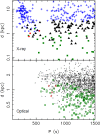The Evolution of Compact Binary Star Systems
- PMID: 28163653
- PMCID: PMC5253975
- DOI: 10.12942/lrr-2006-6
The Evolution of Compact Binary Star Systems
Abstract
We review the formation and evolution of compact binary stars consisting of white dwarfs (WDs), neutron stars (NSs), and black holes (BHs). Binary NSs and BHs are thought to be the primary astrophysical sources of gravitational waves (GWs) within the frequency band of ground-based detectors, while compact binaries of WDs are important sources of GWs at lower frequencies to be covered by space interferometers (LISA). Major uncertainties in the current understanding of properties of NSs and BHs most relevant to the GW studies are discussed, including the treatment of the natal kicks which compact stellar remnants acquire during the core collapse of massive stars and the common envelope phase of binary evolution. We discuss the coalescence rates of binary NSs and BHs and prospects for their detections, the formation and evolution of binary WDs and their observational manifestations. Special attention is given to AM CVn-stars - compact binaries in which the Roche lobe is filled by another WD or a low-mass partially degenerate helium-star, as these stars are thought to be the best LISA verification binary GW sources.
Figures


















Similar articles
-
Relativistic Binaries in Globular Clusters.Living Rev Relativ. 2013;16(1):4. doi: 10.12942/lrr-2013-4. Epub 2013 Mar 4. Living Rev Relativ. 2013. PMID: 28179843 Free PMC article. Review.
-
The Evolution of Compact Binary Star Systems.Living Rev Relativ. 2014;17(1):3. doi: 10.12942/lrr-2014-3. Epub 2014 May 5. Living Rev Relativ. 2014. PMID: 28179847 Free PMC article. Review.
-
Disentangling Coalescing Neutron-Star-White-Dwarf Binaries for LISA.Phys Rev Lett. 2018 Sep 28;121(13):131105. doi: 10.1103/PhysRevLett.121.131105. Phys Rev Lett. 2018. PMID: 30312047
-
The missing link in gravitational-wave astronomy: A summary of discoveries waiting in the decihertz range.Exp Astron (Dordr). 2021;51(3):1427-1440. doi: 10.1007/s10686-021-09713-z. Epub 2021 Apr 29. Exp Astron (Dordr). 2021. PMID: 34720416 Free PMC article.
-
Great Impostors: Extremely Compact, Merging Binary Neutron Stars in the Mass Gap Posing as Binary Black Holes.Phys Rev Lett. 2020 Feb 21;124(7):071101. doi: 10.1103/PhysRevLett.124.071101. Phys Rev Lett. 2020. PMID: 32142310
Cited by
-
Physics of Neutron Star Crusts.Living Rev Relativ. 2008;11(1):10. doi: 10.12942/lrr-2008-10. Epub 2008 Dec 12. Living Rev Relativ. 2008. PMID: 28163609 Free PMC article. Review.
-
Quantum Measurement Theory in Gravitational-Wave Detectors.Living Rev Relativ. 2012;15(1):5. doi: 10.12942/lrr-2012-5. Epub 2012 Apr 26. Living Rev Relativ. 2012. PMID: 28179836 Free PMC article. Review.
-
Binary Neutron Star Mergers.Living Rev Relativ. 2012;15(1):8. doi: 10.12942/lrr-2012-8. Epub 2012 Jul 4. Living Rev Relativ. 2012. PMID: 28163622 Free PMC article. Review.
-
Spectral Methods for Numerical Relativity.Living Rev Relativ. 2009;12(1):1. doi: 10.12942/lrr-2009-1. Epub 2009 Jan 9. Living Rev Relativ. 2009. PMID: 28163610 Free PMC article. Review.
-
Relativistic Binaries in Globular Clusters.Living Rev Relativ. 2013;16(1):4. doi: 10.12942/lrr-2013-4. Epub 2013 Mar 4. Living Rev Relativ. 2013. PMID: 28179843 Free PMC article. Review.
References
-
- Abbott B, Abbott R, Adhikari R, Ageev A, Agresti J, Ajith P, Allen B, Allen J, Amin R, Anderson SB. Search for gravitational waves from binary black hole inspirals in LIGO data. Phys. Rev. D. 2006;73:1–17.
-
- Abbott B, Abbott R, Adhikari R, Ageev A, Agresti J, Ajith P, Allen B, Allen J, Amin R, Anderson SB. Joint LIGO and TAMA300 search for gravitational waves from inspiralling neutron star binaries. Phys. Rev. D. 2006;73:1–10.
-
- Abbott B, LIGO Scientific Collaboration et al. Analysis of LIGO data for gravitational waves from binary neutron stars. Phys. Rev. D. 2004;69:1–16.
-
- Abt HA. Normal and abnormal binary frequencies. Annu. Rev. Astron. Astrophys. 1983;21:343–372. doi: 10.1146/annurev.aa.21.090183.002015. - DOI
-
- Acernese F, VIRGO Collaboration et al. Status of Virgo. Class. Quantum Grav. 2005;22:S869–S880. doi: 10.1088/0264-9381/22/18/S01. - DOI
Publication types
LinkOut - more resources
Full Text Sources
